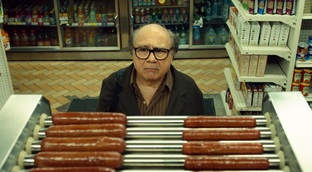Interview with Todd Solondz

Todd Solondz’s new film, Wiener-Dog, opens at Kendall Square Cinema on July 1. The movie is a collection of stories tied together by the presence of the titular cainine, who goes from owner to owner. Why the focus on the animal? The director says he accepts whatever interpretation or reaction viewers have about this or any of his films: he is just happy to have them seen. These are humble words from the creator of seven challenging feature films, narratives that are peppered with cringe-inducing moments of truth.
Solondz understands that audiences find his sensibility odd and puzzling. Scenes that some viewers find funny, others wince at. The director explains that he isn’t interested in writing conventional comedy. For him, every scene in his films (Welcome to the Dollhouse, Happiness) should have a “kind of charge to it” that comes from “cruelty and tenderness, or comedy and pathos rubbing against each other.” He welcomes the “multiplicity of responses” his movies generate — ambiguity is part of their power. When I spoke with Solondz last week, I said that I found movie’s awkward moments to be bracingly tender and honest. When asked about why he chose to focus on a dog, Solondz says: “I knew I wanted to do a dog movie.” The inspiration was Robert Bresson’s 1966 film, Au Hasard Balthazar, a masterpiece about the tragic life of a donkey from birth to death. “I watched that again, and the film has a very oblique narrative. It’s a little wobbly. That freed me a little to use the dog as a kind of conceit because it’s not really about a dog. It’s about mortality and the way it hovers in and shadows each of the stories.” The film is his second working with award-winning cinematographer Ed Lachman who, as he does with Todd Haynes’ films (Carol, Far From Heaven), gets the look right no matter what kind of suburban ambience. Solondz says that he loves collaborating with Lachman: “He is devoted and serious with a great sense of humor. We have a shorthand. If I mention a photographer, he knows who I’m talking about. Going on a scout with him is a pleasure. We don’t build sets, so it’s about finding those spaces and imagining how they will serve the story. It’s not about him any more than it’s about me. It’s about what serves the story.” One of the film’s unique set pieces is its colorful “Intermission.” Wiener-Dog traipses through a succession of obviously projected American landscapes — snowy mountains, deserts, prairies, an urban setting, a disco, a ballpark, and the White House. The animal’s wanderings are accompanied by “The Ballad of Wiener-Dog,” a song by Marc Shaiman and Scott Wittman. “They also wrote the title song for my film Life During Wartime and understood what I was looking for here,” Solondz explains. “In the script all it says is ‘Dog Montage’ because I felt the need for a kind of interlude. I wanted it to feel expansive. I had the idea of putting the dog on a treadmill in front of a green screen. The crew stood around it for about three hours until we could get 12 seconds of usable material. The template for the song is Ghost Riders in the Sky.” The dachshund at the center of the story is actually “three, or four or five dogs.” Regarding having to deal with animals, Solondz says he discovered the pup to be the most challenging. “This breed is profoundly stupid,” he claims. “I say this with sorrow because it comes from inbreeding for the marketplace. They are show dogs, and couldn’t respond to stay, sit, nothing. So it was really hard.” Directing the actors was another challenge, given that the cast represents a range of experience and styles: Danny DeVito, Ellen Burstyn, Kieran Culkin, Julie Delpy, Greta Gerwig, Tracy Letts, Zosia Mamet, and two actors with Downs Syndrome (Connor Long and Bridget Brown) who play a contented married couple. The film has several silent interludes. These scenes give the actors time to settle into the emotional truth of their characters without giving audiences the standard cues supplied by dialogue or music. We are asked to observe these scenes patiently, at times to the point of discomfort. “Every actor is different, so it is my job to figure out what I need from these actors, to enable them, to free them up so they can shine. If they need their hands to be held, I hold their hands. It’s instinct, luck, finding the right chemistry, figuring out how they’ll be responsive.” Casting is key. “Everything is casting,” he says. “That’s really where the movie happens. If you have material that an actor responds to, they like the opportunity to give more.” In one segment, Danny DeVito plays a film professor named Dave Schmerz. The guy finds himself having to listen to the clichéd ambitions of his students while, at the same time, he is desperately pitching his script to Hollywood agents who obviously haven’t gotten around to reading it. Schmerz’s young hip undergrad film students dismiss him as irrelevant and antiquated. How autobiographical is this? Solondz teaches at New York’s Tisch School of the Arts, but his experience in the classroom is much different: “I don’t think I would ever be mistaken for Schmerz.” About teaching, he speaks with enthusiasm: “I love teaching, and I love the students. I have wonderful colleagues. NYU is an evil empire managed with remarkable incompetence, and I have a good situation there.” |
